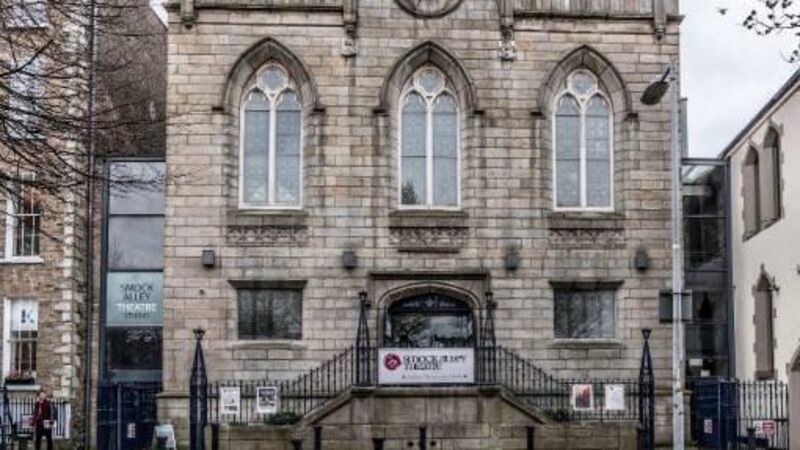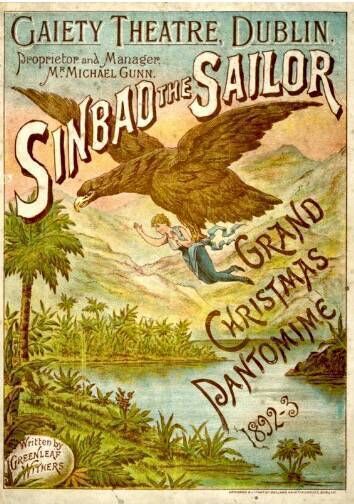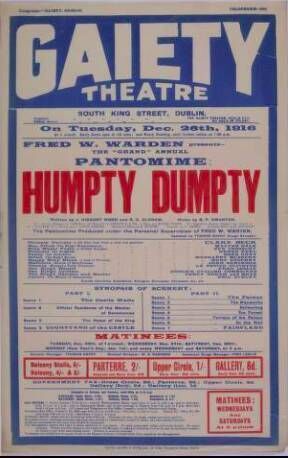Celebrating 250 years of Christmas panto magic in Ireland

Theatre Royal, Smock Alley, Dublin: the epicenter of Irish panto (Irish Family History Centre)
(Cork Examiner, 23 Dec. 1868)
When the curtain went up at the Cork Opera House a few days ago for the first performance of Jack and the Beanstalk, it marked at least 250 years of pantomime in Ireland.
The tradition stretches back to at least December 1774, when crowds packed Dublin’s Theatre Royal in Smock Alley, to watch Her Majesty’s Company of Comedians perform Harlequin’s Funeral.
These days, you generally hear the cries of “Oh yes it is…”, “he’s behind you” and “It is, it is, it is” from early December until some point in dreary January.
But in the past doors could open at any time of the year – from October until July.
Before they became based on fairy tales, many pantomimes in Ireland were Harlequinades.
Flashily attired in a checkered suit, and wielding a magic bat, Harlequin, with his girlfriend, Colombine, the wealthy lord called Pantaloon, and the Clown, were well-known characters from Italian “Commedia dell’Arte”.
True to the Greek origins of the word (“pantomimos”, one who imitates all), Harlequin performed through gesture and expression alone, “danced but never spoke”, says V & A Archivist, Sabrina Offord.
Italians remained heavily involved in the productions.
At the Theatre Royal in Dublin, Pietro Bologna played the Clown in Harlequin’s Folly (1788), Signor Spagnoletti painted the scenery for Black Beard (1817), Joseph Grimaldi directed Cinderella (1820), and Signor Bartolomucci, accompanied by the two “Signoras” De Caro, led the dancing.
Beautiful string puppets (called fantoccini) stole the show at Ali Baba and the Forty Thieves in the Rotunda Rooms (1872), and a hall in Capel Street, Dublin, was named the Fantoccini Theatre.

The whole world and his wife flocked to see the shows.
The Queen’s Royal Theatre, Dublin, is nightly “crowded almost to inconvenience”, reported the Freeman's Journal in January 1858; while on Boxing Night 1865 the galleries at the Theatre Royal were thronged “Olympus high”, and the pit and boxes were “hard-pressed to accommodate their patrons”.
“Irresistibly amusing” clowns kept audiences constantly entertained, with “roars of laughter” never ceasing at the Rotunda Rooms.
By the last performance in mid-January 1864, some 27,000 people had seen Harlequin and the Fair Evaleen at the Prince of Wales’ Theatre in Fishamble Street, Dublin. Some watched it again and again, and never forgot what they witnessed.
While wandering through the streets of Dublin, Leopold Bloom in Ulysses recalled images from Turko the Terrible and Sinbad the Sailor that he’d seen as a boy at the Gaiety Theatre.
Pantomime eventually reached Cork City in December 1868, when Ali Baba and the Forty Thieves was staged at the Theatre Royal.
Though often regarded as holiday entertainment for youngsters, “there are few even verging upon the sore and yellow” who cannot enjoy its wonders, remarked the Irish Examiner.
Next year, the Cork, Blackrock and Passage Railway put on a special late train at 11.15 p.m. to take home passengers from all walks of life in its first, second and third-class carriages.

These days, pantomimes are loud, fast-paced affairs that employ special effects galore: from haze and smoke, to artificial snow and cascading waterfalls. The baddy can be swathed in green light, and strobe introduced for the chase sequence.
If the show doesn’t include flying dragons, floating magic carpets, and levitating sleighs, you’d be demanding a refund.
Before the 1880s, in contrast, devices were mechanical, and only gas lighting was available: 140 gas jets were installed at Cork’s Theatre Royal for Ali Baba in 1868.

Still, there was no shortage of shenanigans. Harlequin’s Invasion (1803) used a “huge trap door” from which characters emerged as if through thin air, while claps of thunder and lightning flashes made audiences jump out of their seats.
In Harlequin and Poor Robin (Theatre Royal, Dublin, 1828) a long black roll of cloth, known as a ‘diorama’, was threaded from one cylinder to the other to depict the flight of a hot air balloon carrying Pantaloon and the Clown.
During Beauty and the Beast at the same theatre (1865), the whole set was suddenly transformed using falling flaps; and at the Cork Opera House (1897) an “animatograph” projector was trialled in the intriguingly titled Little Bo Peep, Little Boy Blue, and the Merry Old Woman who lived in a Shoe.
Some tricks – notably Harlequin leaping through “a brilliant sun of fireworks” at Dublin’s Amphitheatre in 1793 – would give HSE inspectors the screaming abdabs today, when even tossing a few sweets into the audience is banned.

Pantomimes have never been everyone’s cup of tea. In 1877, the Freeman’s Journal playfully dubbed them “the paradise of juveniles”.
Some complained they simply weren’t funny. “The tricks are the dullest and most common place that could well be imagined, and there is a total lack of wit”, wrote one critic after the curtain fell on The Sailor’s Return in December 1838.
Any laughter, he continued, was evoked by “pain and disgust”.
Others saw “comic pantomimes” as vulgar foreign entertainment that threatened the downfall of Shakespeare.
For many years, “serious pantomimes”, such as Raymond and Agnes and The Bleeding Nun, that included ballet dancing and horse displays, provided alternative viewing.
In Dublin, the Gaiety Theatre returned to a selection of popular Irish Dramas for 1877/78.
Only when it became obvious that pantomimes were strictly seasonal did they become more socially acceptable.
Throughout both World Wars, and the 1918 Spanish Flu (unlike during Covid), “King Pantomime” continued to wow Irish audiences with such delights as Mother Hubbard Goes to Town, and Jimmy and the Leprechaun.

By the 1950s and early ’60s, local amateur groups and school pupils were getting involved, and practically every hall in Ireland would stage a production.
In 1961, for instance, the De La Salle Past Pupils’ Union in Macroom, offered “three hours of sparkling comedy” inside The Enchanted Cave; while at the Dramatic Society’s hall in Castletownberehaven, Little Red Riding Hood’s “racy script” brought “capacity audiences”.
Before the 1960/61 season was through, an incredible 25,000 people – many clambering onto special buses – had descended on the tiny village of Coachford (population 150) to watch Aladdin, “a show that eclipses all”, according to the Examiner.

Since Harlequin King Nutcracker and Barney O’Toole and the Giant Hobble Gobble, way back in Victorian times, new features have been added to our annual fest: sing-alongs and pantomime horses and cows, topical jibes and nods to the local community – not forgetting the infamous catchphrases.
A bilingual Irish and English pantomime was held last year in Cork City. But it's still the basics that pantomime thrives upon: cheeky innuendo, heroes and villains, good eventually triumphing over evil.
The Freeman’s Journal once called pantomime “the great lion of the Christmas holidays”, an “institution”, without which Christmas “could be barely said to be”.
Now, who could possibly disagree? IT IS, IT IS, IT IS!









